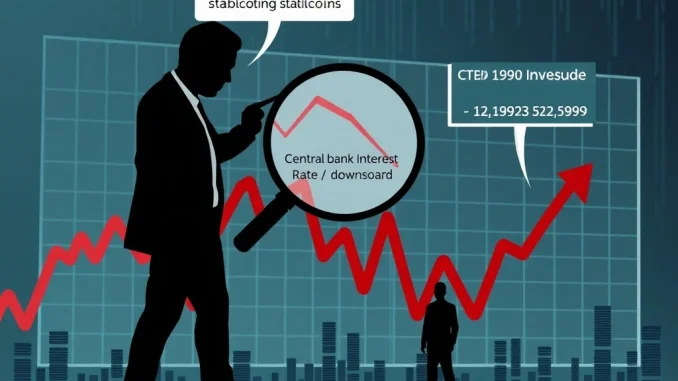
The cryptocurrency market is no stranger to volatility, but when a major player like Circle, the issuer of the popular USDC stablecoin, receives a significant downgrade from a reputable investment bank, it sends ripples. Recent news reveals that analysts at U.S. investment bank Compass Point have taken a decisive step, downgrading Circle’s investment rating to “sell” from “neutral,” signaling potential headwinds for the company and the broader stablecoin ecosystem. This isn’t just a minor adjustment; it comes with a lowered share price target of $130, prompting crucial questions about the future trajectory of one of crypto’s most prominent firms and the impact of this Circle downgrade.
Why the Circle Downgrade? Unpacking Compass Point’s Concerns
Compass Point’s decision to issue a ‘sell’ rating on Circle wasn’t arbitrary. Their analysis, as reported by Decrypt, points to three primary factors that collectively paint a challenging picture for the stablecoin giant. Understanding these reasons is key to grasping the current market dynamics and what they mean for companies operating within the digital asset space.
- Increased Stablecoin Competition: The stablecoin landscape is no longer dominated by just a few players. New entrants and established competitors are aggressively vying for market share, putting pressure on USDC’s dominance.
- Fed Rate Cut Expectations: Anticipated reductions in interest rates by the Federal Reserve could directly impact Circle’s revenue model, which heavily relies on yields from its reserve assets.
- Reduced Retail Investor Interest: A cooling in general retail investor enthusiasm for cryptocurrencies translates to lower demand for stablecoins used in trading and investment, affecting Circle’s transaction volumes.
These factors combined suggest a less favorable environment for Circle’s financial performance moving forward.
The Rising Tide of Stablecoin Competition: A Key Factor
For years, USDC stood as a formidable competitor to Tether’s USDT, often lauded for its transparency and regulatory compliance. However, the market has evolved rapidly. We’re seeing an explosion of new stablecoin projects, some backed by traditional financial institutions, others by decentralized protocols, and even national central bank digital currencies (CBDCs) looming on the horizon. This intensifying stablecoin competition means that Circle must work harder to maintain its market position and attract new users. Every new stablecoin launch, every new partnership, and every regulatory shift can chip away at USDC’s market share, directly impacting Circle’s growth prospects and revenue generation.
Navigating the Fed Rate Cut Crypto Landscape
One of Circle’s primary revenue streams comes from the interest earned on the reserves backing USDC. These reserves are typically held in highly liquid assets like U.S. Treasury bills. When the Federal Reserve raises interest rates, as it has done significantly in recent years, Circle benefits from higher yields on these reserves. Conversely, the prospect of a Fed rate cut crypto environment means these yields will likely decrease. This directly impacts Circle’s profitability and financial outlook. For crypto investors, this also highlights how macroeconomic policies can have a tangible effect on even seemingly stable parts of the digital asset market, influencing broader crypto investment strategies.
Shifting Crypto Investor Sentiment: What Does it Mean?
The cryptocurrency market is notoriously cyclical, often driven by waves of enthusiasm and caution. Compass Point’s observation of reduced retail investor interest points to a broader trend of cooling sentiment after periods of intense speculation. When retail investors pull back, there’s less demand for stablecoins like USDC, which are frequently used to enter and exit crypto positions, or to hold value during market volatility. This dip in crypto investor sentiment can lead to lower transaction volumes for Circle, impacting its fee-based services and overall usage. It underscores the interconnectedness of market participants and the foundational role stablecoins play in facilitating broader crypto activity.
The Future of USDC Stablecoin: Challenges and Opportunities
Despite the recent downgrade, it’s important to put the situation into perspective. The USDC stablecoin remains a cornerstone of the decentralized finance (DeFi) ecosystem and a trusted asset for many users. Circle has built a strong reputation for its commitment to transparency, regular attestations of its reserves, and proactive engagement with regulators. While the challenges highlighted by Compass Point are real – increased competition, potential revenue squeeze from lower rates, and fluctuating investor interest – Circle also has avenues for growth. This could include expanding its enterprise solutions, venturing into new geographic markets, or innovating with new product offerings beyond just stablecoin issuance. The downgrade serves as a stark reminder that even established crypto companies face intense scrutiny and must continuously adapt to evolving market conditions.
A Critical Juncture for Circle and the Stablecoin Market
The Compass Point downgrade of Circle to ‘sell’ is a significant event that reflects a complex interplay of market forces. It underscores the growing maturity and competitiveness of the stablecoin sector, the direct impact of macroeconomic policy on crypto businesses, and the ever-present influence of investor sentiment. While the immediate outlook presents challenges for Circle, the company’s strong foundation and strategic positioning suggest it’s well-equipped to navigate these headwinds. For investors and users, this news serves as a reminder to stay informed about the evolving landscape of digital assets and the underlying financial health of the companies that power them. The stablecoin market is dynamic, and vigilance remains key.
Frequently Asked Questions (FAQs)
Q1: What does it mean for an investment bank to ‘downgrade’ a company like Circle?
A downgrade means the bank’s analysts believe the company’s stock or investment prospects are less favorable than previously thought. In Circle’s case, Compass Point moved its rating from ‘neutral’ to ‘sell,’ suggesting they recommend investors divest or avoid the company’s shares due to anticipated underperformance.
Q2: How does a Fed rate cut impact stablecoin issuers like Circle?
Stablecoin issuers like Circle earn revenue by investing the reserves that back their stablecoins, often in interest-bearing assets like U.S. Treasury bills. A Fed rate cut reduces the interest yield on these assets, directly decreasing the potential revenue Circle can generate from its reserve holdings.
Q3: Is USDC stablecoin still safe to use after this downgrade?
Yes, the downgrade of Circle’s investment rating does not directly affect the safety or peg of the USDC stablecoin. USDC’s stability is maintained by its backing with high-quality, liquid reserves. The downgrade relates to Circle’s profitability and growth prospects as a company, not the integrity of the USDC peg itself.
Q4: What is ‘stablecoin competition’ and why is it a concern for Circle?
Stablecoin competition refers to the increasing number of stablecoins entering the market, all vying for user adoption and market share. This includes rivals like USDT, new fiat-backed stablecoins, and even potential central bank digital currencies. Higher competition can lead to reduced market dominance, lower transaction volumes, and pressure on fees for existing players like Circle.
Q5: How does ‘retail investor interest’ affect Circle’s business?
Retail investors are a significant source of demand for stablecoins, using them for trading, holding value, or participating in DeFi. When retail interest in the broader crypto market wanes, the demand for stablecoins used in these activities also decreases, impacting Circle’s transaction volumes and overall business activity.



